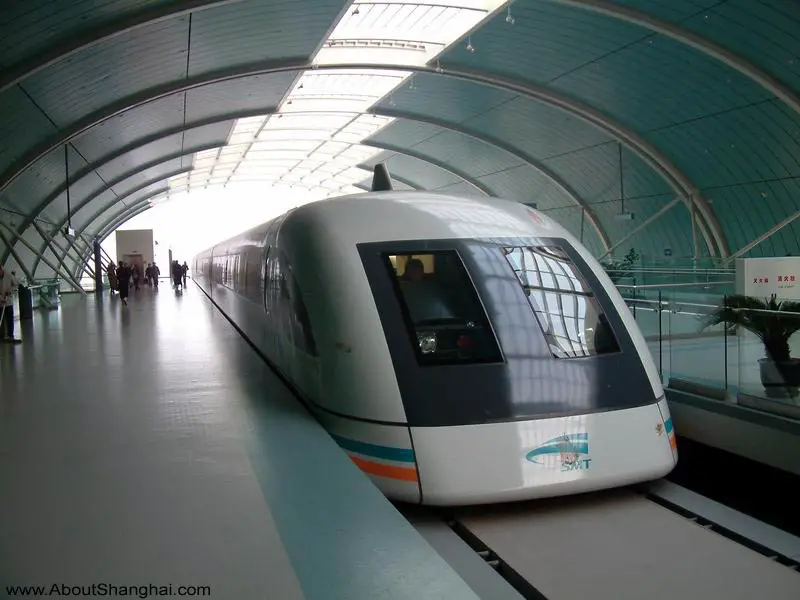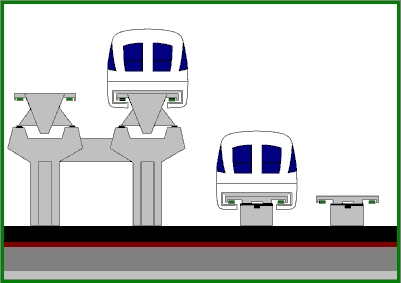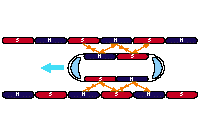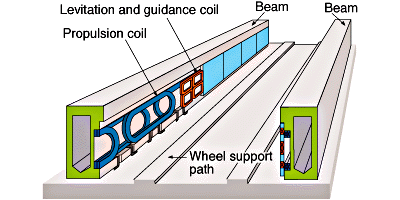
We have always thought of aeroplanes as the fastest mode of transportation. As it travels thousands of miles in an hour we do not mind the flight delays and also the risk in flying. There is no other alternative to planes that can travel such a great distance in minimum amount of time. Buses, cars, boats and even conventional trains seem to be too slow in comparison to planes.
Now a new transportation mode has occurred that can clearly compete with planes in both speed and safety. They are called MAGLEV trains. The full form and the basic working principle of MAGLEV is called Magnetic Levitation.
Magnetic Levitation
The principle of magnetic levitation is that a vehicle can be suspended and propelled on a guidance track made with magnets. The vehicle on top of the track may be propelled with the help of a linear induction motor. Although the vehicle does not use steel wheels on a steel rail they are still referred to as trains as by definition they are a long chain of vehicles which travel in the same direction. This is the definition of a MAGLEV train.

As the frictional parts are minimum in this type of technology, the MAGLEV trains are known to have more speed, smoothness and less sound.
Working of MAGLEV Train
The train will be floating about 10mm above the magnetic guiding track. The train will be propelled to move by the guide way itself. Thus, there is no need of any engine inside he train. The detailed working of MAGLEV train is shown in the figure below. The train is propelled by the changing in magnetic fields. As soon as the train starts to move, the magnetic field changes sections by switching method and thus the train is again pulled forward. The whole guide way is run by electromagnets so as to provide the magnetic effect.

Thus the power needed for the whole process is less when compared to a conventional electric train. Amongst the power used, only a little is used for the levitation process. But a higher percentage of power is needed to overcome air friction.
MAGLEV v/s Conventional Train
The main difference between both the trains is that conventional trains need steel wheels and a steel track for their movement and MAGLEV does not need wheels. They travel under the principle of electromagnetic suspension.
Another difference is in the engine used. MAGLEV trains do not need engines like conventional trains. The engine used for conventional trains provide power to pull a chain of compartments along steel tracks. In MAGLEV trains, the power to propel the train is provided by the magnetic fields created by the electric coils kept in the guidance tracks which are added together to provide huge power.
MAGLEV Track
The track along which the train moves is called the guide way. Both the guide way as well as the train’s undercarriage also have magnets which repel each other. Thus the train is said to levitate about 0.39 inches on top of the guide way. After the levitation is complete, enough power has to be produced so as to move the train through the guide way. This power is given to the coils within the guide way, which in turn produces magnetic fields, which pulls and pushes the train through the guide way.

The current that is given to the electric coils of the guide way will be alternating in nature. Thus the polarity of the coils will be changing in period. Thus the change causes a pull force for the train in the front and to add to this force, the magnetic field behind the train adds more forward thrust.
Commercial use of MAGLEV Trains
- The first known commercial use of MAGLEV train was in the year 1984 in Birmingham, England, and the train was named MAGLEV itself. But due to less reliability, the train was stopped by 1994.
- The most famous commercial MAGLEV train is the Shanghai MAGLEV train in Shanghai, China. The train can go in a top speed of 270 miles/hour with an average speed of 160 miles/hour.
- Since these trains move on a cushion of air, there is no friction at all [except air friction]. The trains are also aerodynamically designed which enables them to reach great speeds like 300 miles/hour and so on. At 300 miles/hour you can travel from Rome to Paris in about 2 hours.
EMS and EDS Systems
Some of the greatest developers of the MAGLEV trains are Germany and Japan. Although the basic concepts used for the construction are the same, the prototypes used are different. German trains use electromagnetic suspension (EMS) system so as the bottom of the train is wrapped to a steel guide way. Thus levitation occurs between the electromagnets that are attached underneath the train and the guide way to about 1 centimetre. It also helps in keeping the train in levitation, when it is standing still. Such trains were tested to go on a maximum speed of about 300 miles/hour with passengers on-board.
In Japan, MAGLEV trains use a technology called electro-dynamic suspension (EDS) system, which causes the trains to move due to the repelling force of magnets. The main difference with EMS is that, the electromagnets used will be super cooled and superconducting. Such magnets are prone to conduct current even if there is no power supply. Thus EDS system helps to save more power than EMS system. But the cooling mechanism and thus the initial cost will be expensive.
In EDS systems, the levitation distance is almost 10 centimetres above the guide way. This distance will need the use of rubber tires for the initial lift-off speed of the train [up to 62 miles/hour]. Since the EDS system produces superconducting magnetic field, people having pacemakers will have to be guarded from magnetic fields.
Advantages of MAGLEV
- The main advantage is maintenance. There is no contact between the guide way and the train which lessens the number of moving parts. Thus the components that wear out is little.
- Another advantage is the reduction in noise. As there are no wheels running along there is no wheel noise. However noise due to air disturbance will still be there.
- The next advantage is high speed. As there are no frictional contacts, the train is prone to have more speed.
- Another advantage is that the guide way can be made a lot thicker in uphill places, after stations and so on. This will help in increasing the speed of the train further.
Disadvantages of MAGLEV
The initial cost of MAGLEV trains are highly costly. The guide paths are also supposed to be more costly than conventional steel railways.
Environmental Friendliness of MAGLEV Trains
MAGLEV trains are more environmentally friendly than other types of trains. In terms of energy consumption maglev trains are slightly better off than conventional trains. As there is no wheel friction with the ground, the resistive force gradually increases in the air friction. Thus the energy efficiency difference between a MAGLEV train and a conventional train is of very small margin.

54 Comments
Maglev trais are really an intresting thing.
this is a nice place they tell you every thing you need to know
hi everyone,
I’m working on my project on maglev car for about 3 years.I’m final year BE in mechanical.contact me,if anyone interested to join with me or any info about maglev power sources.it would help me in many occasions of my project.thank you.ill be available any time
no thanks
where we used such type of maglev cars….. I mean that there is no magnets in track
where you planning on putting magnets somewhere on the inner fender of the car and somewhere in the tire to create the rotation?
Sir,
Am also a btech final year student. And am doing a modification on the current maglev train. Sir could you please provide me the basic electrical equation regarding the levitation and propulsion. Since am a mechanical engineering student i have less knolegde on magnetism and its functioning, am working on it.
Kindly provide the details.
Thank You
we are working on, working model of maglev train project in B.Tech final year,we need help from you.can you send some helpfull links describing the complete idea and from where we can get the all required materials.
i really want to know who got the idea of this awsome train
fully intresting and something gainful site…..
very well
http://maglev.com.tr
Very Usefull ! Thank You .
Really Good !
Hi…. give me a information about maglev trak design in details for maglev lavitation trains……
Sir I want to just ask two questions
How that different polerity type magnetism occures????.
And the circuit connection of truck magnetic field and trains magnetic field.
you could check out the principle and working of oscillators.
This website is very helpful, however you are not explaining how the train works (in depth). This information is very helpful indeed.It has help me in many of my essays. Thank you for who ever did this report.
sir it is very excellent but your not telling about the working of engine principals and break system. please send the clear report about this project
sir it is very excellent but your not telling about the working of engine principals and break system. please send the clear report about this project sir
I need Breaking system explanation please.
this info is very useful ……. to understand how the magnetic levitation work
please send me information regarding the magnetic levitation train
Sir, we want to make project on maglev train …. we want detail working …we think to make track of v shape with coiling on all sides…
Hello Shivraj,
We are not able to help you at this moment with a project on Maglev trains. Sorry for that.
really a nice project do..
can i have the circuit diagram and all the detailed description of the MAGLEV train?
waiting for ur response
reply soon..
Hello Renu,
We have developed this article as a tutorial explaining the working of MAGLEV train. It is not an electronics project 🙂 Thanks.
plese can u provide a detailed information and circuit diagramabout manglav train
witing for response
plz reply soon
I’m final year electrical engineering student and want to do a project on maglev train ….will you suggest me how i proced….
i want to know how the train moves while starting
& the time of applying of breaks.can i have the circuit diagram and all the detailed description of the MAGLEV train?
waiting for ur response
really a nice project do..
can i have the circuit diagram and all the detailed description of the MAGLEV train?
waiting for ur response
reply soon..
very nice and awesome thanks for ur information
waa………………… this was nice concept
one favor that need was can i know that how the breaks are applied to this train
This is interesting…..!!Can you please send me the basic operation with more details of this train with electrical circuit diagrams if possible and explain breaking system of this train please!!
i want to know how the train moves while starting
& the time of applying of breaks
best explanation……………
Thanks for the detailed interesting explanation. I am very much facinated by this wondering technology and oneday I want to travel in my future. Australia is far behind in introducing new technologies and contraint by highcost, I dont expect to have a chance here. Definitly I need to travel China (one thing is safety) or better to Germany or Japan where technologies are very advance.
waa what a great technology really….i was feeling too good by knowing about this maglev trains..thanks for the great engineers…
good explanation
hi please send me information regarding the magnetic levitation train
THANKYOU VERY MUCH!!!
when MAGLEV trains will be commercially used in India……??????!!!
Hi Sumit,
Kerala is introducing MAGLEV Trains for the first time in India.
I need iformation regarding meglev aplication for colombia s.a. who is the manufacturing company so that i cantact hem them now,,, my name manuel polanco and my email,,mapoto8904_8@hotmail.com plese contact me at your earlist convinience, thaks,,,
its a good information ..tqvm…but, if u dont mind,can u plz tell me how about the regenerative braking works in electric railway systems…thank you very much..
All of my qeutsoins settled-thanks!
I’m experimenting about magnetic force. Will you, please, send me a detailed comment about the functioning of MAGLEV?
THANKYOU VERY MUCH!!!
hi’Carlos//////////////////////////////////////////////////////////////////////////I’m also experimenting on magnetic field.I need more experiment on magnetic force .Can you some helpe me on this topic.I’m So thankful to you.
who so ever invented this idea has a very good indeed thes best engineering I would really like to ask you about the functioning in detail & I do appretiate the jolyman9@gmail.com hey buddy can you please send me the functioning if this train in detail I would be highly obliged!!!!!!! 😀
would you please send me the functioning of this train. I really appreciate at jolyman9@gmail.com
@ Donald
Yes, the train has been commercially used in China and Germany since 2002. It s bult and developed by a German company called Transrapid International.
it is a very goood form of transport.
will you please mail me about its functioning
i will be highly thankfull to you.
Has this train been deployed anywhere in the world